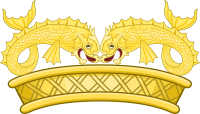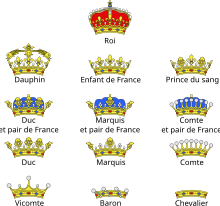
In British heraldry, a coronet is any crown whose bearer is less than sovereign or royal in rank, irrespective of the crown's appearance. In other languages, this distinction is not made, and usually the same word for crown is used irrespective of rank (German: Krone, Dutch: Kroon, Swedish: Krona, French: Couronne, Italian: Corona, etc.) In this use, the English coronet is a purely technical term for all heraldic images of crowns not used by a sovereign, and implies nothing about the actual shape of the crown depicted. A Coronet is another type of crown, but is reserved for the lower ranks of nobility like Marquesses and Marchionesses, Earls and Countesses, Barons and Baronesses, and some Lords and Ladies. The specific design and attributes of the crown or coronet signifies the hierarchy and ranking of its owner.
Certain physical coronets are worn by the British peerage on rare ceremonial occasions, such as the coronation of the monarch. These are also sometimes depicted in heraldry, and called coronets of rank in heraldic usage. Their shape varies depending on the wearer's rank in the peerage, according to models laid down in the 16th century. Similar depictions of crowns of rank (German: Rangkronen) are used in continental heraldry, but physical headgear has never been made to imitate them.
Due to the extreme rarity of occasions in which peers' coronets are worn (sometimes more than fifty years pass before a new coronation and occasion to wear physical coronets), practical use of the term coronet today is almost exclusively confined to pictorial crowns and rank symbols in heraldry, adorning someone's coat of arms (indeed, many people entitled to a coronet never have a physical one made). Depiction of ordinary crowns or coronets in heraldry, rather than coronets of rank, including a variety of crest coronets sometimes placed under the crest, are not confined to peers, and are often shown in British heraldry outside the peerage.
| Part of a series on |
| Heraldic achievement |
|---|
| External devices in addition to the central coat of arms |
|
|
The word stems from the Old French coronete, a diminutive of co(u)ronne ('crown'), itself from the Latin: corona, lit. 'crown, wreath' and from the Ancient Greek: κορώνη, romanized: korōnē, lit. 'garland, wreath'.
Traditionally, such headgear is used by nobles and by princes and princesses in their coats of arms, rather than by monarchs, for whom the word 'crown' is customarily reserved in English, while many languages have no such terminological distinction. As a coronet shows the rank of the respective noble, in the German and Scandinavian languages there is also the term rangkrone (literally 'rank crown').

Traditionally, in the United Kingdom, a peer wears the coronet on one occasion only: for a royal coronation, when it is worn along with coronation robes, equally standardised as a luxurious uniform. However, for the 2023 coronation of King Charles III, on the government's advice, the King forbade the wearing of coronets by those peers who had been invited, except those performing specific ceremonial roles.[1]
In the peerages of the United Kingdom, the design of a coronet shows the rank of its owner, as in German, French and various other heraldic traditions. Dukes were the first individuals authorised to wear coronets. Marquesses acquired coronets in the 15th century, earls in the 16th and viscounts and barons in the 17th. Until the barons received coronets in 1661, the coronets of earls, marquesses and dukes were engraved while those of viscounts were plain. After 1661, however, viscomital coronets became engraved, while baronial coronets were plain. Coronets may not bear any precious or semi-precious stones.[2]
Since a person entitled to wear a coronet customarily displays it in their coat of arms above the shield and below the helmet and crest, this can provide a useful clue as to the owner of a given coat of arms. In Canadian heraldry, descendants of the United Empire Loyalists are entitled to use a Loyalist military coronet (for descendants of members of Loyalist regiments) or Loyalist civil coronet (for others) in their arms.

Members of the British royal family often have coronets on their coats of arms, and may wear actual coronets at coronations (e.g., Princesses Elizabeth and Margaret at the 1937 coronation of their father as George VI). They were made according to regulations instituted by King Charles II in 1661, shortly after his return from exile in France (getting a taste for its lavish court style; Louis XIV started monumental work at Versailles that year) during the Restoration. They vary depending on the prince's relationship to the monarch. Occasionally, additional royal warrants vary the designs for individuals. The most recent (and most comprehensive) royal warrant concerning coronets was the 19 November 1917 warrant of George V.[5]
The coronet of the heir apparent is distinctive in itself as it has a single arch with a globe and cross.
Charles III abolished the use of coronets at his coronation in 2023 for both members of the Royal Family and peers.
| Image | Details |
|---|---|
| Princes and Princesses | |

|
Child of a sovereign
A coronet of crosses and fleurs-de-lis. |

|
Child of an heir apparent
A coronet of crosses, strawberry leaves and fleurs-de-lis. |

|
Child of a son of a sovereign
A coronet of crosses and strawberry leaves. |

|
Child of a daughter of a sovereign[2]
A coronet of strawberry leaves and fleurs-de-lis. |
| (Non-royal) Peers and Peeresses | |

|
Duke or Duchess
A silver-gilt circlet, chased as jewelled but not actually gemmed, with eight strawberry leaves of which five are seen in two-dimensional representations. |

|
Marquess or Marchioness
A coronet of four strawberry leaves and four silver balls (known as "pearls", but not actually pearls), slightly raised on points above the rim, of which three leaves and two balls are seen. |

|
Earl or Countess
A coronet of eight strawberry leaves (four visible) and eight "pearls" raised on stalks, of which five are visible. |

|
Viscount or Viscountess
A coronet of sixteen "pearls" touching one another, nine being seen in representation. |

|
Baron or Baroness, Lord or Lady of Parliament
A plain silver-gilt circlet, with six "pearls" of which four are visible. |
Certain types of local government have special coronet types assigned to them.
| Image | Details |
|---|---|

|
Coronet of a Scottish Regional Council (1973–1996)
A circlet richly chased from which are issuant four thistles leaved (one and two halves visible) Or.[6] |

|
Coronet of a Scottish Island Council (1973–1996)
A circlet richly chased from which are issuant four dolphins two and two respectant naiant embowed (two visible) Or.[7] |

|
Coronet of a Scottish District Council (1973–1996)
A circlet richly chased from which are issuant eight thistle heads (of which three and two halves are visible) Or.[8] |

|
Coronet of a Scottish Community Council (1973–present)
A circlet richly chased from which are issuant four thistle leaves (one and two halves visible) and four pine cones (two visible).[9] |
All over the world, Spanish heraldry has used these crowns and coronets:

The hierarchy among the French nobility, which was identical for non-royal titles to the British hierarchy of peers, should not be understood to be as rigid in the ranking of titleholders as the latter. In particular, a title was not a good indication of actual preeminence or precedence: ancestry, marriages, high office, military rank and the family's historical renown counted far more than the precise title. Some distinguished families held a title no higher than count or even baron, but were proud of their ancient origin. Moreover, most of the nobility was legally untitled. Some hereditary titles could be acquired by a nobleman who purchased a "titled" fief, while titres de courtoisie ('courtesy titles') were freely assumed in the absence of strict regulation by the French crown and became more numerous than titles legally borne. In the 17th and 18th centuries, people assumed and used freely coronets of ranks that they did not have; and, in the 19th and 20th centuries abuse was still made of 'courtesy titles'. Titles continued to be granted until the Second Empire fell in 1870, and legally survive among their descendants.
The only title that was never usurped under the ancien régime, and rarely without some excuse afterwards, was the title of duc – because it was so often attached to the rank of peer of France, which carried specific legal prerogatives, such as the right to a seat in the Parlement of Paris. As a result, the title of duc was actually, as well as nominally, at the top of the scale after the royal family and foreign princes, and a cut above all of the other nobility. During the ancien régime, 'prince' was a rank, not a title, hence there was no coronet.

The Holy Roman Empire, and consequently its successor states (Austria, Germany and others), had a system very similar to that of the British, although the design varied.
Considering the religious nature of the Holy Roman Empire, one can say that, except for the short-lived Napoleonic states, no continental secular system of heraldry historically was so neatly regulated as under the British crown. Still, there are often traditions (often connected to the Holy Roman Empire, e.g., those in Sweden, Denmark or Russia) that include the use of crown and coronets. While most languages do not have a specific term for coronets, but simply use the word meaning crown, it is possible to determine which of those crowns are for peerage or lower-level use, and thus can by analogy be called coronets.
Precisely because there are many traditions and more variation within some of these, there is a plethora of continental coronet types. Indeed, there are also some coronets for positions that do not exist or entitle one to a coronet in the Commonwealth tradition. Such a case in French (ancien, i.e., royal era) heraldry, where coronets of rank did not come into use before the 16th century, is the vidame, whose coronet (illustrated) is a metal circle mounted with three visible crosses (there is no documentary or archeological evidence that such a coronet was ever made).
Often, coronets are substituted by helmets, or only worn on a helmet.
Although these crowns/coronets were usually granted with arms, sometimes the coronet was not granted.
These coronets and crowns were used in Portuguese heraldry: